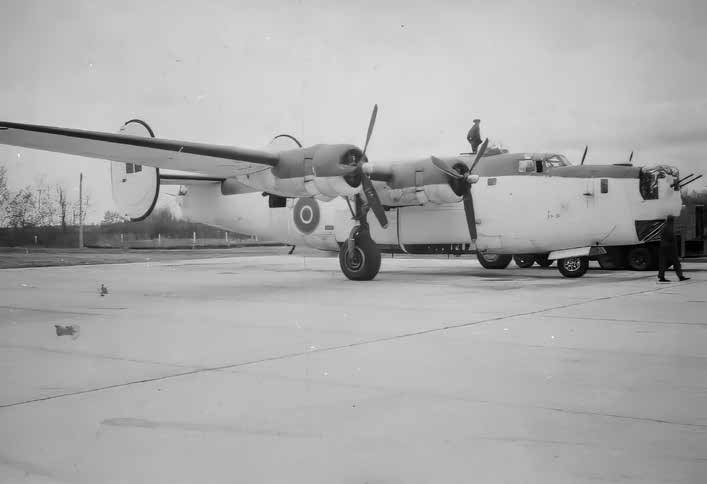The Battle of the Atlantic, the “Air Gap,” and the Delay in Allocating Liberators to the Royal Canadian Air Force
DOI :
https://doi.org/10.25071/2561-5467.1254Mots-clés :
Royal Navy, Royal Air Force, US Army Air Forces, trade defence, Sir Winston Churchill, Second World War, US NavyRésumé
La crise la plus grave de la bataille de l’Atlantique est survenue à la fin de 1942 et au début de 1943, lorsque les forces sousmarines allemandes se sont stationnées dans la région centrale de l’océan, hors de la portée des forces aéronavales terrestres des Alliés. Bien que des avions plus performants aient été disponibles, on ne leur a attribué un rôle maritime qu’au printemps de 1943. Le présent article propose une nouvelle méthodologie visant à comprendre les raisons de ce retard en étudiant les interactions complexes entre les marines, les forces aériennes et les politiciens des trois puissances alliées principalement responsables de la défense commerciale dans l’océan Atlantique – soit la Grande-Bretagne, les États-Unis et le Canada – et en examinant les difficultés particulières auxquelles faisait face l’Aviation royale canadienne.
Références
Barley, Frederick and David Waters. The Defeat of the Enemy Attack on Shipping, 1939-1945, edited by Eric Grove. Aldershot, UK: Ashgate for the Navy Records Society, 1997.
Barnett, Correlli. Engage the Enemy More Closely. New York: Norton, 1991.
Bell, Christopher M. “Air Power and the Battle of the Atlantic: Very Long Range Aircraft and the Delay in Closing the Atlantic ‘Air Gap’.” Journal of Military History 79, no. 3 (July 2015): 691-719.
Bell, Christopher M. “The View from The Top: Winston Churchill, British Grand Strategy, and the Battle of the Atlantic.” In Decision in the Atlantic, edited by Marcus Faulkner and Christopher M. Bell. Lexington: University Press of Kentucky, 2019.
Buckley, John. The RAF and Trade Defence, 1919-1945: Constant Endeavour. Keele, UK: Ryburn Publishing, 1995.
Craven, Wesley F. and James L. Cate, eds. The Army Air Forces in World War II, 7 vols. Chicago: University of Chicago Press, 1948-58.
Dimbleby, Jonathan. The Battle of the Atlantic: How the Allies Won the War. New York: Viking, 2015.
Douglas, W.A.B. The Creation of a National Air Force. Toronto: University of Toronto Press, 1986.
Douglas, W.A.B., Roger Sarty, Michael Whitby, et al. No Higher Purpose: The Official Operational History of the Royal Canadian Navy in the Second World War, 1939-1943, vol. II, pt. 1. St. Catharines, ON: Vanwell, 2002.
Douglas, W.A.B., Roger Sarty, Michael Whitby, et al. Blue Water Navy: The Official Operational History of the Royal Canadian Navy in the Second World War, 1943-1945, vol. II, pt. 2. St. Catharines ON: Vanwell, 2007.
Douglas, W.A.B. and David Syrett, “Die Wende in der Schlacht im Atlantik: Die Schliessung des “Gronland-Luftlochs” 1942-3,' 83 Marine Rundschau (1986): 2-11, 70-3, 147-9.
Gilbert, Martin. The Churchill Documents, vol. 17. Hillsdale, MI: Hillsdale College Press, 2014, vol. 17.
Goette, Richard. “Britain and the Delay in Closing the Mid-Atlantic ‘Air Gap’ during the Battle of the Atlantic.” The Northern Mariner/Le marin du nord 15, no. 4 (October 2005): 19-41. https://doi.org/10.25071/2561-5467.512
Goette, Richard. “Service Cultures, Personalities, and the Struggle to Establish a Joint Headquarters in Halifax during the Second World War.” The Northern Mariner/Le marin du nord, 33, nos. 3-4 (Fall-Winter 2023): 353-368, https://doi.org/10.25071/2561-5467.1165.
Goette, Richard. “Squadron Leader N.E. Small: A Study of Leadership in the RCAF’s Eastern Air Command, 1942.” Canadian Military Journal 5, no. 1 (Spring 2004): 43-50. https://www.journal.forces.gc.ca/vo5/no1/mh-hm-eng.asp
Lund, W.G.D. “The Royal Canadian Navy’s Quest for Autonomy in the North West Atlantic.” In RCN in Retrospect, 1910-1968, edited by James A. Boutilier. Vancouver: UBC Press, 1982, 138-57.
Milner, Marc. Battle of the Atlantic. St. Catharines, ON: Vanwell, 2003.
Milner, Marc. “The Battle of the Atlantic.” Journal of Strategic Studies 13, no. 1 (1990): 45-66.
O'Connell, John F. “Closing the North Atlantic Air Gap: Where did all the British Liberators go?” Air Power History 59, no. 2 (Summer 2012): 32-43.
Richards, Denis and Hilary St. George Saunders, The Royal Air Force, 1939-1945, 3 vols. London: HMSO, 1954-1959.
Roskill, Stephen. Churchill and the Admirals. London: Collins, 1977.
US, Department of State, Foreign Relations of the United States: The Conferences at Washington, 1942 and Casablanca, 1943. Washington, DC: US Government Printing Office, 1968.
Webster, Charles and Noble Frankland. The Strategic Air Offensive Against Germany 1939-1945, vol. 1. London: HMSO, 1961.

Téléchargements
Publié-e
Comment citer
Numéro
Rubrique
Licence
© The Northern Mariner / Le marin du nord 2025

Cette œuvre est sous licence Creative Commons Attribution - Pas d'Utilisation Commerciale 4.0 International.
